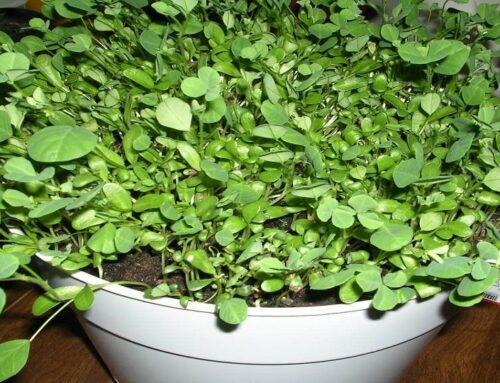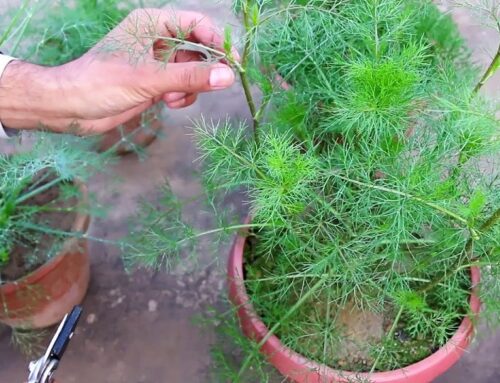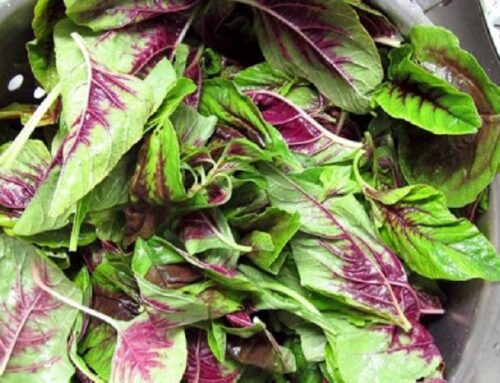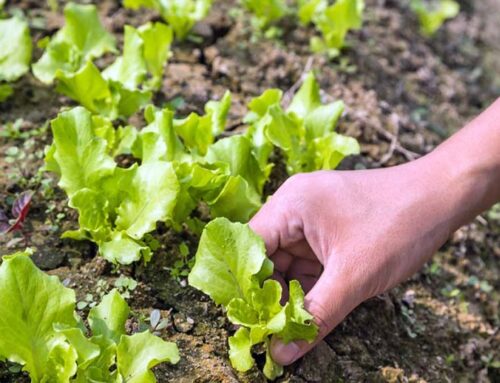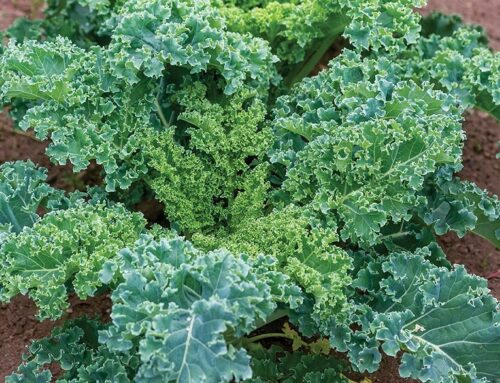Spearmint is an erect-stemmed, vigorous-growing mint species with quadrangular purple-green, hairy stems. Scientific name of spearmint is Mentha spicata. This variety of mint is called spearmint because of its ‘spear-shaped’ or ‘pointed’ leaf tips. Flowering stems are narrow and long. Pink- or white-coloured flowers are borne on terminal, slender flowering spikes. The plant reaches up to a height of 60 to 100 cm upon full growth. Flowering time is from mid and late summer to early and mid fall.
Spearmint is mainly grown for its aromatic leaves which are used for culinary purposes as well as for oil extraction. Spearmint oil is rich in an aromatic compound called R-carvone which imparts the spearmint oil its characteristic aroma and flavour. Unlike peppermint, spearmint contains very less amounts of menthol and menthone.
Origin and Distribution: Spearmint is a native to the temperate regions of Europe and South West Asia. It is widely distributed throughout the temperate regions of North America.
Growing Spearmint: Spearmint grows well in nearly all temperate climates. Spearmint is best suited to loamy soils with plenty of organic material. Soil pH requirement is about 5.5 – 7.5. The plant prefers partial shade; but can flourish both in full sun and shaded locations. Spearmint does not set seed and its flowers are sterile. Propagation is done mainly by dividing rhizomes, from herbaceous stem cuttings and sometimes by planting suckers.
While planting, the planting materials are spaced at 35-50 inches (90-120 cm) apart. Planting is done when temperature is around 20°C. Planting depth is about 0.5 cm-1 cm deep in furrows.
The land is repeatedly ploughed twice or thrice, levelled and made free of all weeds before planting. In commercial cultivation practices, FYM (farm yard manure) or compost or vermicompost @ 15 – 30 tons/hectare along with NPK @ 40, 60 and 40 kg /hectare is mixed with the top soil at the time of land preparation.
In Zinc-deficient soils, 20 kg of ZnSO should be mixed in the soil in order to avoid Zn deficiency. Nitrogen@80 Kg/hectare is also given as top dressing in 2 doses; first dose is 40 days after planting and second dose is given after the appearance of the first flush.
Organic manures are generally incorporated into the top soil at the time of land preparation. Nitrogenous fertilizers such as urea are broadcasted between the plant rows once plants are established.
Regular watering is needed until plants get established and thereafter, need-based watering is done. Overwatering and water logging should be avoided.
Weeding is done thrice during the crop growth. One weeding each before every harvest is recommended. Manual weed control is the most ideal method for a mint crop.
There is no severe insect-pest damage or disease incidence observed in spearmint plantation. Occasionally, some fungal diseases such as powdery mildew or Verticillium Wilt may be observed.
Verticillium Wilt is a soil-borne fungal disease caused by Verticillium dahliae. The disease may occur at any growth stage of the plants. Major symptoms include yellowing of leaves and stunted growth. Since the disease is soil-borne, the best control measures include soil sterilization before planting the crop and adopting cultural practices such as crop rotation and field sanitation. Powdery Mildew is a fungal disease caused by the fungus Leveillula taurica. It is prevalent in warm, humid climate and it primarily affects the leaves. Symptoms include appearance of white, powdery mass of fungal spores on the entire lower leaf surface and the affected leaves eventually fall off. Regular dusting with sulphur and potassium bicarbonate may control the disease up to some extent.
Sometimes, spearmints are susceptible to insects such as beetles, whitefly and aphids. They can be controlled by spraying any of the recommended bioinsecticides such as neem emulsion or tobacco solution or soap solution. Ladybugs are natural predators of aphids and can be used as a biocontrol agent in large spearmint plantations.
Spearmint leaves lose their aroma after the plant begins to flower and therefore harvesting is recommended just before flowering. Fresh leaves are harvested just before flowering stage on dry sunny days. 2-3 harvests in a year may be done. During harvesting, fresh herbage is cut 10 cm above the ground by using a sharp knife.
Yield of fresh herbage from commercial plantations ranges from 25 to 30 tons/ha and yield of oil is approximately 150 liters/ha.
According to the convenience of the grower, different containers such as plastic bags and cloth bags may be used for storing processed spearmint leaves. Different lighting conditions such as open sunlight and/or shaded dark chambers may be used for drying spearmint leaves.
Open Field Sun Drying: Harvested fresh herbage is left in the field in the open sun for 4–6 hours for wilting until the fresh herbage loses 50% of its moisture.
Air Drying under Shade: Freshly harvested leaves are spread on a screen and dried in the shade. When the leaves and stems are brittle, excess stems are removed and dried leaves are cleaned before storing them in airtight containers.
Steam Distillation: Dried herbage (dried leaves and flowering tops) is transported to the distillation site where it is chopped into small pieces and distilled in a steam distillation unit to extract spearmint oil.
Spearmint oil is highly aromatic and is rich in R-carvone (up to 65%). Carvone is the active compound that gives the oil its distinctive medicinal and aromatic properties. Spearmint oil is rich in linalool also which provides its caraway-like odor.
Uses of Spearmint Leaves and Oil: Both spearmint leaves and spearmint oil have several culinary, medicinal and commercial uses. Both fresh and dried leaves are used in various culinary preparations. Spearmint oil is very high in carvone content and therefore has great demand in medical and cosmetic industries. A description of various uses of spearmint is given below:
Culinary and Food Uses: Fresh spearmint leaves are pungent with a pleasant aroma and flavour and hence popular among homemakers as a garnishing agent in various food preparations such as fried rice, spicy meat preparations, chutney and sauce preparations. Fresh spearmint leaves are an essential ingredient of famous Touareg Mint Tea which has great health benefits because of its high antioxidant activity. Spearmint tea is also a natural home remedy for stomach aches and mild digestive problems. Spearmint leaves may also be used for flavouring mineral water.
Nutrition in Fresh Spearmint: Fresh leaves are an excellent source of dietary fiber. A 100g of edible portion contains about 6.8g of dietary fiber. It has low calorific value also, approx. 44 kcal per 100g. Fresh spearmint leaves are considered as a rich source of minerals and vitamins such as Vitamin A (4054 IU/100g) and Vitamin C (13.3mg/100g).
Nutrition in Dried Leaves: Dried/dehydrated spearmint is richer and concentrated source of minerals, vitamins and dietary fiber.
At room temperature, fresh spearmint leaves lasts for only 2-3 days. It can be preserved for a long time by freezing. Salt, sugar or sugar syrup, alcohol, and oil may also be used for preserving fresh spearmint for a considerable period of time. Dried and dehydrated leaves may be stored in air tight glass containers.
Medicinal Uses of Spearmint: Spearmint oil is used as carminative oil, which soothes the digestive system. Fresh spearmint leaves are used to prepare mint tea which is used to treat stomach ache.
Commercial Uses of Spearmint: Spearmint oil is used as a flavouring agent for toothpastes and mouth cleaners. Spearmint oil is used as a base flavouring agent in many commercial scale food, beverage, and confectionery products. It is also used in skincare products, perfumes, shampoos and soaps as well as in aromatherapy.
We have a book on ‘Mint Herbs‘….
Check out our publishing services here…
We publish top quality videos on various ‘Food & Agriculture’ topics. You may subscribe our video channel here…


